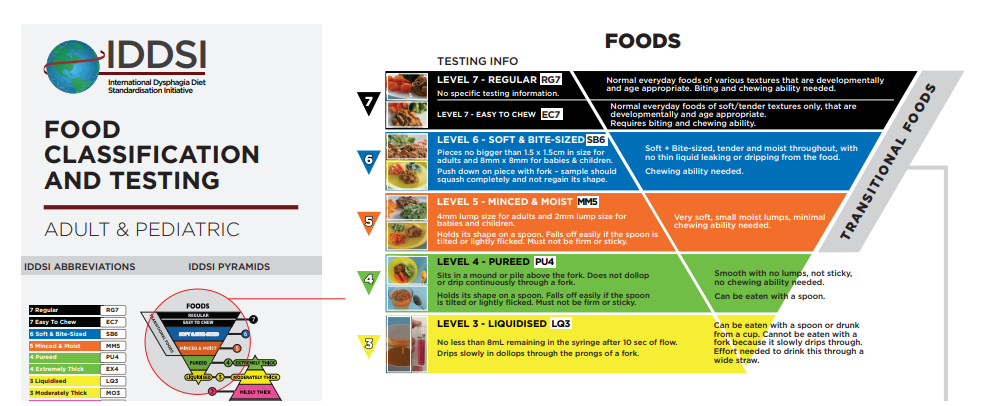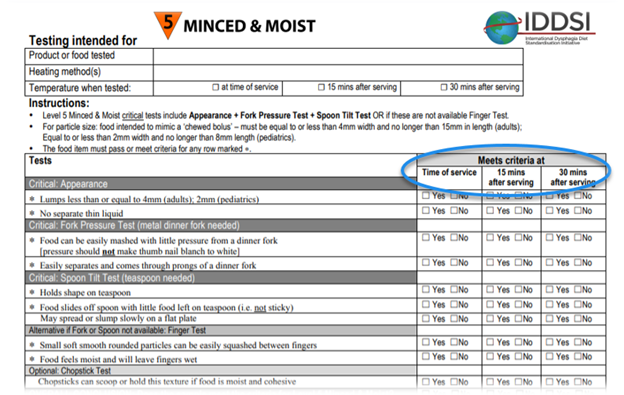
IDDSI Exploration Series, Part 3: IDDSI Food Testing In 3 Simple Steps
Welcome back to the IDDSI Exploration series! On week one of National Dysphagia Month, we started a foundation by covering where IDDSI is now – and then moved on to explore Updated Food Lists and Level 7 Easy to Chew. If you haven’t had the chance to check out the first two articles, we encourage you to do so now! Next up, we are dipping in to IDDSI food testing.
The IDDSI food lists provide a starting point for understanding what foods and food types are included for each level, but they are just that – a starting point (for more information on the updated IDDSI food lists, or to consider how you might use the lists in your own facility, check out our Week 2 article here). The next step is to build on that study with tactile practice. This week we are reviewing IDDSI food testing, through three simple steps to apply the testing methods consistently, safely and effectively.
Step 1: Get Familiar with What Each Test is Actually Testing
IDDSI has developed six main tests for food texture, and one test for liquids. This is less intimidating than it may sound, as many of the levels share one or more of the same testing methods.1 A good introduction to the methods, when to use them, and for which levels is available in the IDDSI Testing Methods (PDF)1available under the Resources tab of the IDDSI website2. All the tests are designed to be performed in a variety of settings, requiring only basic tools available in most food preparation environments. IDDSI has even included a testing method for the most basic of equipment, the Finger Pressure Test, to help provide criteria for a tool accessible in situations where other tools may not be.1 Audit sheets clearly outline which tests are considered critical to complete for each level3 (see a sample Level 5 Audit Sheet Here), and when combined with printable test cards can help streamline the testing process and offer clarity for commercial and home kitchen use. The test cards and other implementation tools will be discussed in more detail next week. The critical food tests include (details for these food tests shown as part of Figure 1, below)1,4:
- Fork Drip Test: A hybrid test for fluid foods and thick drinks (Levels 3 and 4); the sample is piled on a fork and then assessed, including how much of the sample flows through the tines/prongs.
- Spoon Tilt Test: Used to determine the stickiness and cohesiveness of a sample.
- A test for assessing particle size compliance: Uses the tines/prongs of a fork to gauge the width of food particles. Uses different parts of the fork to measure 4 mm (Level 5), and 15 mm (Level 6).
- Fork/Spoon Pressure Test: Used to observe a food sample’s behavior when pressure is applied and after that pressure has been removed.
- Fork/Spoon Separation Test: To pass this test a food sample must be able to break apart easily with the side of a fork or spoon.
(Note the Finger Pressure and Chopstick tests can be used for many of these tests as well. See individual Audit Sheets for more information)

Figure 1. IDDSI Framework Adult and Paediatrics – Foods (Poster). (c) The International Dysphagia Diet Standardisation Initiative 2016 @https://iddsi.org/framework. Used under CreativeCommons Attribution Sharealike 4.0 License - https://creativecommons.org/licenses/by-sa/4.0/legalcode. Also see Reference 4 at end of this article for more information and original poster link.
The remaining food test utilizes the fork pressure test as Step 2 of a 2-step process and can be used to assess foods which start out as one texture and change into another, such as after the addition of moisture. This is the “Transitional Food Test”, and more information on this texture test can be found here.4 Liquids and thickened liquids should be classified using the IDDSI Flow Test.5 A 10 mL sample is placed in a syringe and allowed to flow freely out of the nozzle of the syringe for 10 seconds. The liquid is then assigned a level based on the amount of liquid remaining in the syringe. A useful video demonstrating this in a side-by-side comparison of Levels 1-3 is available on the IDDSI YouTube channel here. It may be helpful to take a minute before conducting any test to consider “what is this specific test analyzing (softness, stickiness, viscosity)?” to think more critically about the purpose of the test being done and anticipated results. The information provided here is intended as a general overview of the testing methods, but as mentioned above we suggest everyone engaging in, or teaching, the IDDSI testing methods, read the full IDDSI Testing Methods document available on the IDDSI website.1
Step 2: Timing and Temperature are Key
The IDDSI tests were designed to analyze the characteristics of solids and liquids as a patient or resident would receive them. This means to enhance the accuracy of the tests they should be done on samples under the intended serving conditions. For example, if a food item is to be served hot, the test should be done on a hot sample. If the food item will be hot held for 1-2 hours before serving, the sample should be tested after it has been hot held, not immediately after cooking as the patients/residents will not receive the food immediately after cooking. Similarly, the same goes for cold items. Diced cooked fruits for instance, even if drained, will likely exude additional fluid if allowed to sit for 30 minutes prior to serving (even at <40F/4C). If additional fluid is exuded, it is important to be aware of this so action can be taken to reduce choking risk, such as stirring in a thickener prior to serving. The effects of timing and temperature can be even more evident in liquids, including changes in both hot and cold liquids over time as explored in more detail here. The Audit Sheets provided by IDDSI include guidelines for testing criteria at given intervals to help monitor a sample’s behavior over time, as shown below (Figure 2).

Figure 2. IDDSI Level 5 - Minced and Moist Audit Sheet. (c) The International Dysphagia Diet Standardisation Initiative 2016 @https://iddsi.org/framework. Used under CreativeCommons Attribution Sharealike 4.0 License - https://creativecommons.org/licenses/by-sa/4.0/legalcode. Also see Reference 3 at end of this article for more information and original link.
Step 3: Assemble Your Toolbox
Fortunately, this step should not take long as the tests were designed to require little to no special equipment, and to be executed successfully in a range of settings. The general tools required include a fork, spoon, chopsticks, fingers, and a 10 mL ‘slip tip’ (or ‘Luer slip tip’) plastic syringe. Details on recommended syringe barrel and nozzle size can be found in the IDDSI Frequently Asked Questions.6 Make sure the tools used for the IDDSI food tests at your facility are consistent to help minimize any variation between tests due to materials used. It may also be helpful to print and laminate a reference poster from the “IDDSI Posters” tab under Resources on the website. Examples of posters available include What testing methods are required for each level, a Combined level classification/testing poster, and summary of the Flow test.
How often should you test? At a minimum a food or recipe should be tested the first time it is used, then periodically if its preparation has not changed from the initial testing. If there is a change in procurement (e.g. an ingredient needs to be swapped for another ingredient), a change in season/temperature of the food preparation area, or other shift in situation such as hiring new staff, the tests should be done again to ensure the food item still meets necessary criteria. It is also a good idea to read the entire Frequently Asked Questions document from the IDDSI website.6 This document addresses many common questions regarding the framework, assigning levels, transitional foods, and other common queries, such as “Why are the terms ‘honey’ and ‘nectar’ not used in the framework?”, “What if a test sample falls directly between two levels?”, and “Won’t smoothies and soups clog up a flow test syringe?” This resource can be a great supplement to the information provided by the food lists and testing method handouts, supporting a more well-rounded understanding of the framework’s development and use.
Be sure to join us next week for the final installment of our IDDSI Exploration Series, featuring tips for implementation and final thoughts. Do you know of someone who would benefit from this information? Be sure to share this with them! Until next time, have a safe and wonderful week.
About the Author
 April is a registered dietitian with experience in menu design, clinical research, acute care, and integrative education. She received her Master of Science degree in Human Nutrition from the University of Minnesota Graduate School, after working four years in clinical research studying the health effects of green tea catechins in postmenopausal women. She completed her dietetic internship with The Emily Program in Minneapolis/St.Paul, before gaining a clinical foundation in the Medical/Surgical and Renal units as a clinical dietitian. Prior to joining MealSuite®, April worked in the nonprofit sector with older adults teaching nutrition classes, outpatient counseling, and developed a cooking curriculum for hands-on immersive adult education. Her current role at MealSuite® provides an opportunity to bring flavor, excitement and variety to therapeutic and texture-modified recipes and menus, to help keep mealtime inviting while staying familiar, for patients and clients. A Minnesota native, she now enjoys exploring the Texas scene with her husband and dog outside of Dallas.
April is a registered dietitian with experience in menu design, clinical research, acute care, and integrative education. She received her Master of Science degree in Human Nutrition from the University of Minnesota Graduate School, after working four years in clinical research studying the health effects of green tea catechins in postmenopausal women. She completed her dietetic internship with The Emily Program in Minneapolis/St.Paul, before gaining a clinical foundation in the Medical/Surgical and Renal units as a clinical dietitian. Prior to joining MealSuite®, April worked in the nonprofit sector with older adults teaching nutrition classes, outpatient counseling, and developed a cooking curriculum for hands-on immersive adult education. Her current role at MealSuite® provides an opportunity to bring flavor, excitement and variety to therapeutic and texture-modified recipes and menus, to help keep mealtime inviting while staying familiar, for patients and clients. A Minnesota native, she now enjoys exploring the Texas scene with her husband and dog outside of Dallas.
References:
1. IDDSI Framework Testing Methods 2.0. IDDSI.org, 2019. Accessed online June 2020.
2. Resources. IDDSI.org. Accessed online June 2020.
3. “Level 5 - Minced and Moist”. Implementation Resources: Audit Sheets. IDDSI.org. Accessed online June 2020.
4. IDDSI Framework Adult and Paediatrics – Foods (Poster PDF). IDDSI.org, 2019. Accessed online June 2020.
5. IDDSI Flow Test Test Card. IDDSI.org, 2020. Accessed online June 2020.
6. Frequently Asked Questions (FAQ). IDDSI.org, October 2016. Accessed online June 2020.

 HOME
HOME